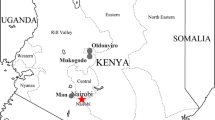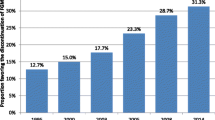Abstract
Female genital cutting (FGC) continues to be widespread particularly in sub-Saharan African countries. We use data from the 1999 Nigeria Demographic and Health Survey to consider factors that influence attitudes toward this procedure held by Nigerian women aged 15–49. We test four models: model 1 explores whether attitudes are consistent with a view of FGC as a social convention associated with marriageability of women. Model 2 examines the impact of modernization factors such as education and urbanization. In model 3, the influence of media and community activities are considered. Model 4 includes all of the factors in the three previous models. We find strong support for considering FGC a social convention. Modernization has minimal impact on attitudes about FGC mainly through its influence on the social convention.
Similar content being viewed by others
Notes
Female genital cutting is also referred to as female genital mutilation (FGM) and female circumcision. We use FGC in the literature review as the terminology female circumcision minimizes the severity of the surgery in some cases and female genital mutilation is viewed as judgmental and pejorative. Female genital cutting is a more neutral term describing what takes place.
We use the term “circumcision” in the methods and analysis because that is how the questions were asked to respondents in the DHS.
The survey also collected information from men (N = 2,680), although these data are not used in our analysis.
Of the 8,918 eligible women identified in sample households, 8,199 responded, yielding a 92% response rate.
About 15% (1,257) of woman did not report an answer to this question. We omit these women from the analysis.
For circumcised women, varying the educational level does have some influence on the predicted probability of favoring continuing circumcision. Setting education at zero years increases the probability of favoring continuing by about 10% for both traditional and nontraditional women; conversely, setting education at twelve years decreases the probability by about 10% from the predicted probability with mean education.
References
Althaus, F. A. (1997). Female circumcision: Right of passage or violation of rights? International Family Planning Perspectives, 23(3), 130–133. Retrieved 20 September 2004 from http://www.agi-usa.org/pubs/journals/2313097.html.
Browne, D. (1991). Christian missionaries, western feminists and the Kikuyu clitoridectomy controversy. In B. Williams (Ed.), Politics of culture (pp. 243–272). Washington, DC: Smithsonian Institute.
Carr, D. (1997). Female genital cutting: Findings from the Demographic and Health Surveys program. Calverton MD: Macro International.
Daly, M. (2000). African genital mutilation: The unspeakable atrocities. In E. A. Jones, G. A. Olson, & M. G. Perry (Eds.), The gender reader (pp. 462–486). Needham Heights, MA: Allyn and Bacon.
Foster, C. (1992). On the trail of a taboo: Female circumcision in the Islamic world. Contemporary Review, 35(6), 244–249.
Horowitz C. R., & Jackson, J. C. (1995). Female “circumcision”: African women confront American medicine. Paper presented at Society of General Internal Medicine. Retrieved 6 June 2002 from http://www.fgm.net.
Johns Hopkins University. (2003). Anti-female genital cutting program in Nigeria. Baltimore, MD: Johns Hopkins University. Retrieved 23 November 2004 from http://jhuccp.org/africa/com_mob/nigeria_fgc.shtml.
Johnson, B. E., & Wernet-Beyer, C. (2001). Factors associated with female genital mutilation: A cross-national analysis of African countries. Paper presented at the Southern Demographic Association Annual Meetings. Miami, Florida.
Kassindja, F., & Bashir, L. M. (1999). Do they hear you when you cry? New York: Dell Publishing.
Kouba, L. J., & Muasher, J. (1985). Female circumcision in Africa: An overview. African Studies Review, 28(1), 95–110.
Lightfoot-Klein, H. (1989). The sexual experience and marital adjustment of genitally circumcised and infibulated females in the Sudan. The Journal of Sex Research, 26(3), 375–392.
Mackie, G. (1996). Ending footbinding and infibulation: A convention account. American Sociological Review, 61(6), 999–1017.
Mackie, G. (2000). Female genital cutting: The beginning of the end. In B. Shell-Duncan, & Y. Yernland (Eds.), Female circumcision in Africa: Culture, controversy, and change (pp. 253–282). Boulder, CO: Lynne Rienner Publishers.
Mandara, M. (2003). Female genital mutilation in Nigeria. International Journal of Gynecology and Obstetrics, 84(3), 291–298.
Mousette, K. A. B. (1996). Female genital mutilation and refugee status in the United States—a step in the right direction. British Columbia International and Comparative Law Review, 356–357.
National Population Commission [Nigeria]. (2000). Nigeria demographic and health survey 1999. Calverton, MD: National Population Commission and ORC/Macro.
Nussbaum, M. (1999). Sex and social justice. Oxford, England: Oxford University Press.
Obi, S. N. (2004). Female genital cutting in south-east Nigeria. International Journal of Gynecology and Obstetrics, 84(2), 183–184.
Orubuloye, I. O., Caldwell, P., & Caldwell, V. (2000). Female “circumcision” among the Yoruba of Southwest Nigeria: The beginning of change. In B. Shell-Duncan, & Y. Yernland (Eds.), Female circumcision in Africa: Culture, controversy, and change (pp. 73–94). Boulder, CO: Lynne Rienner Publishers.
Population Reference Bureau. (2002). Abandoning female genital cutting prevalence, attitudes, and efforts to end the practice. Retrieved 16 January 2002 from http://www.measurecommunication.org/Content/NavigationMeasure_Communicati.
Retlaff, C. (1999). Female genital mutilation: Not just “over there.” Journal of the International Association of Physicians in AIDS Care. Retrieved 14 August 2002 from http://www.iapac.org.
Reproductive Health Outlook. (2003). Harmful health practices annotated bibliography. Retrieved 7 January 2003 from http://www.rho.org.
Rice, J. (2001). A successful case is made for granting refugee status to woman fleeing her own country to protect her daughter from female genital mutilation. Retrieved 17 May 2001 from http://Law.gonzaga.edu.
Shell-Duncan, B., Obiero, W. O., & Muruli, L. A. (2000). Women without choices: The debate over medicalization of female cutting and its impact on a Northern Kenyan community. In B. Shell-Duncan, & Y. Yernland (Eds.), Female circumcision in Africa: Culture, controversy, and change (pp. 109–128). Boulder, CO: Lynne Rienner Publishers.
Tostan. (2005) About Tostan, Tostan Woman’s Health and Human Rights. Retrieved 24 January 2005 from http://www.tostan.org/about.htm.
Toubia, N., & Izett, S. (1998). Female genital mutilation: An overview. Geneva, Switzerland: World Health Organization.
United States Department of State. (2001). Nigeria: Report on female genital mutilation (FGM) or female genital cutting (FGC) (2001). Washington, DC: Office of the Senior Coordinator for International Women’s Issues. Retrieved 21 August 2002 from http://www.state.gov/g/wi/rls/rep/crfgm/10106.htm.
Van der Kwaak, A. (1992). Female circumcision and gender identity: A questionable alliance? Social Science and Medicine, 35(6), 777–787.
Yoder, P. S., & Henry, R. (2002). Female genital cutting a coming of age in Guinea. Calverton MD: MeasureDHS+. Retrieved 9 August 2002 from http:\\www.measuredhs.com/about/qualitativeflyers2.pdf.
Acknowledgments
An earlier version of this paper was presented at the 2003 Southern Demographic Association Annual meeting. We want to thank Christine Wernet for her help with earlier stages of this research. Data for this study come from the 1999 Nigeria Demographic and Health Survey, downloaded from the Demographic and Health Survey Data Archive. The opinions expressed in this paper are those of the authors.
Author information
Authors and Affiliations
Corresponding author
Rights and permissions
About this article
Cite this article
Freymeyer, R.H., Johnson, B.E. An exploration of attitudes toward female genital cutting in Nigeria. Popul Res Policy Rev 26, 69–83 (2007). https://doi.org/10.1007/s11113-006-9016-3
Published:
Issue Date:
DOI: https://doi.org/10.1007/s11113-006-9016-3




